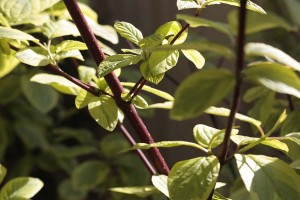Here are a few more photos from My previous post looked at the Cultivar Garden and Wildflower Meadow at Rancho Santa Ana Botanic Garden. Today I’m sharing a couple more categories of what you’ll find there: shade gardens and California natives grown in containers.
Parts of Rancho look wild, and the shade plantings fall into that category. Coral bells and iris form a dense green carpet and pink
This place is very much a tended garden, but these many acres of oaks under-planted with drought-tolerant shade plants buzz with a wild vibe. Benches under the oaks humanize the space and let you know things are under control.
Most of us probably don’t have anything approaching the acreage to pull this off at home. Places like this are great to appreciate plantings taken really big.
I liked the starry yellow flowers in this planting. Bloomeria, maybe?
Closeup of the yellow flowers…
A killer group planting like this makes me think that my little row of coral bells at home is lame by contrast.
Moving out into semi-shade I found this iris. Many plants near it were labeled. This one was not. CalFlora didn’t help with the ID, so if any of you have any ideas, let me know!
By contrast to the shady woodlands the demonstration container garden looks totally suburban and attainable. It’s much smaller in scale and the corrugated steel fence-walls give the space a sheltered backyard sort of feel. There’s a golf course on the other side of the fence (not part of the garden) to provide comfort if all the nature-looking plantings in other parts of the garden scare you.
The tallest plant in this photo is a variegated form of Cornus sericea, ‘Hedgerows Gold.’
Here’s a detail of the foliage, yellow-green with darker green splotches. Yes, the leaves are really cool, but so are the red twigs. This is a great plant even in winter, after the leaves have dropped.
Ceanothus Silver Surprise was another option with variegated foliage.
In the container garden they have a couple of these sculptural knots of dead plant parts. Primal and just a tad scary.
Most of the potted plants looked urban, but a few moved back towards nature, like this pot of bunchgrasses interplanted with wildflowers. Here the gilia was in bloom.
I took more photos, but you get the idea…
Be sure to go for a visit if you’re in the neighborhood. And you wouldn’t go wrong planning a little vacation around it.














It is always a pleasure to escape, for a few moments, from our green and wet to your silvery and dry surroundings. I feel warmer already.
Hmm. Iris bracteata?
No, erase that.
Bloomeria is a plant?
Looks like Hypoxis. Bulb with 3 ranks of leaves, and starry yellow flowers.
Good note on the scale and challenge of pulling such an effect off for a smaller property. Nice variety of treatments, and the various container displays are primo.
“Attainable” is something I rarely see attained (or wanted), such as at the Desert Botanical Garden in Phx. You or I might see how to abstract such grandeur with our various design inclinations, but most cannot. But I would be happy for a client to pay our RT airfare there for me to show them all day what they might apply, well except maybe summer.
James, I looked at photos at the USDA plants database site to see if I could identify your iris. The only one they showed growing in California that looks like this is Iris pseudacorous — but it’s most definitely not a native and is classified as invasive in many states, including Washington and Oregon. It seems like an unlikely species to have in a native plant botanical garden.
Hands down, RSABG is my favorite botanical garden. They also have two native plant nurseries (one in Westwood and the other in Claremont at the gardens). I’ve been a member for years and look forward with great anticipation for their hugely popular fall plant sale every November. The selections are amazing!
Arleen, the plant sale is on my bucket list, and your comment makes me want to get there sooner than later. Everyone who goes to it comes away amazed. If I lived as close as you do to the garden I’d be up there, checking on the seasons, watching the plants change throughout the year. It’s a great place, even with all the budget woes they’ve had to deal with the last few years.